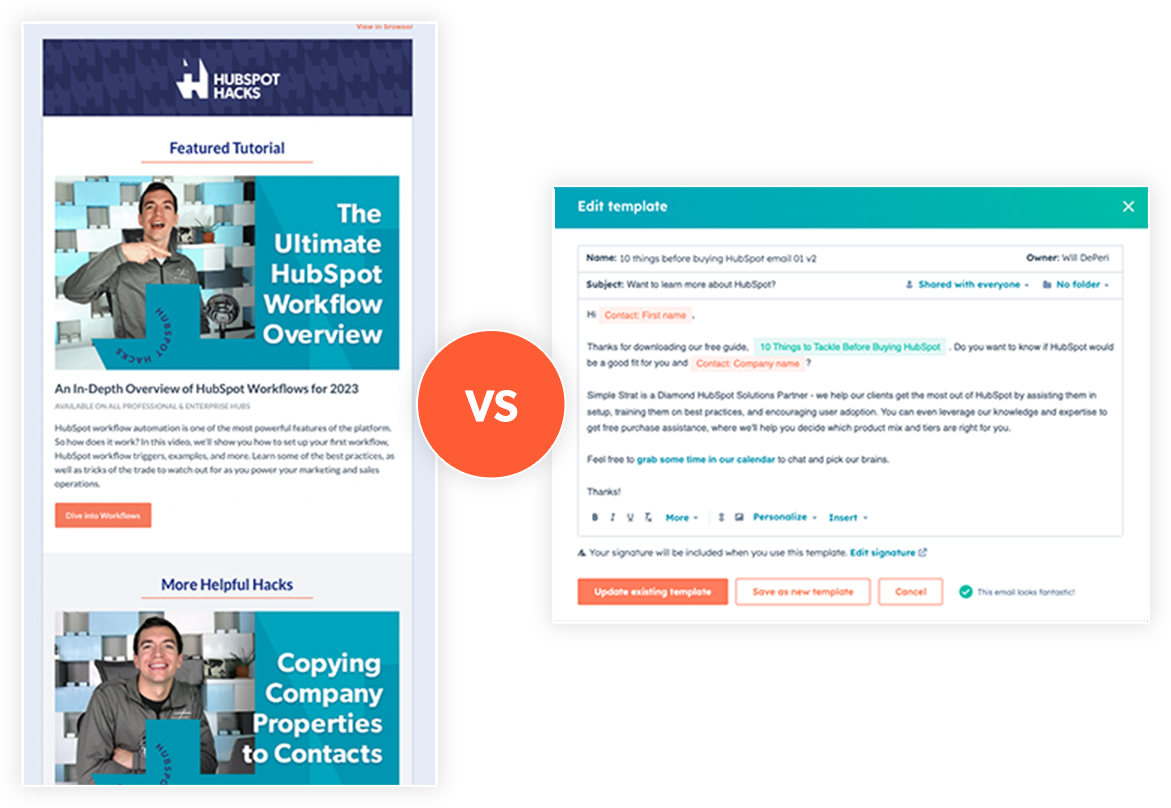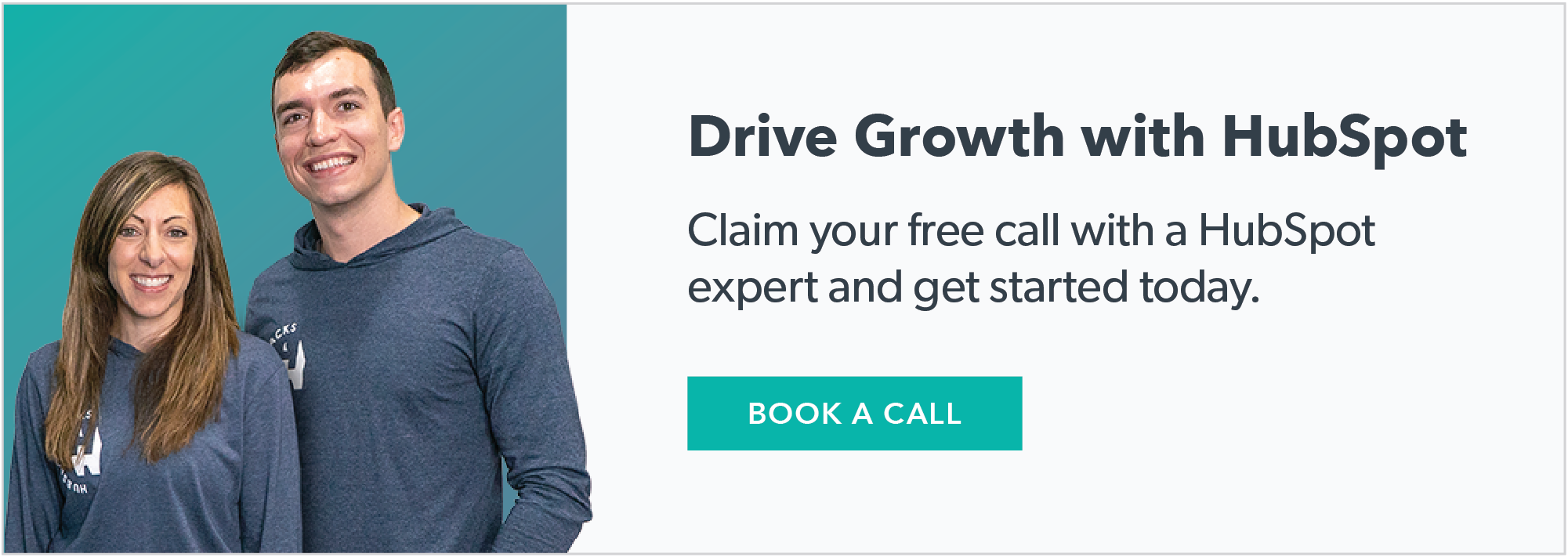Your business is growing, and you're exploring the vast ocean of opportunities that HubSpot offers to help you engage with your customers effectively. But if you’re like many users, you may find yourself confused about the different email types nested in different sections of HubSpot.
So, what exactly is the difference between HubSpot “marketing emails” vs “sales emails”?
User beware: using these email types the wrong way can lead to missed opportunities, inefficient communication and even CAN-SPAM act violations (aka a domain shutdown or fines may be in your future, yikes!), so let’s make sure you’re harnessing the full potential of HubSpot..
No worries, though, with proper understanding of how to use these email tools correctly in HubSpot, you'll have an easier time generating leads, optimizing conversions, and boosting customer satisfaction.
Want a quick master class? Watch the HubSpot Hack about these two email types. Or keep reading for a more comprehensive overview!
HubSpot Marketing Emails vs Sales Emails
HubSpot Marketing Emails: One-to-Many Communication
Marketing emails in HubSpot are found under the marketing dropdown menu. These emails are designed for one-to-many communication, meaning one message is sent to many recipients at once.
Some examples of marketing emails include instances where you’re working to engage them after they’ve taken an action on your site, such as:
- Lead nurturing
- Webinar invites
- Follow-up emails after an asset download (like an ebook)
- Newsletters
- Promotional campaigns
Marketing emails are sent from the server you set up for email sending. If not configured correctly, they may come “via HubSpot”, so make sure you have your domains set up properly.
You can find this information in Settings >> Website >> Domains, or refer to this knowledge article for additional detail.
Note: Many organizations use marketing emails to distribute information to a large audience simultaneously. These emails often have a "from a list" label when viewed on devices like iPhones.
Sales Emails: One-to-One Communication at Scale
Sales emails, on the other hand, are designed for one-to-one communication at scale and can be found in the sales function of HubSpot.
Unlike marketing emails, sales emails usually have minimal formatting and graphics, making them look more like personal emails.

Sales emails (or 1-to-1 emails as we call them) can be sent through:
- Sequences: These emails are sent to multiple recipients but appear as if they're sent one by one (sequences are found under the “Automation” dropdown).
- Individual contact records: When you send an email to a specific contact from their record, it's considered a one-to-one email.
Using these one-to-one emails will require setting up your personal email (i.e. personal work email — don’t use an @gmail or @outlook email address).
Some common scenarios where you would want to use a sales email include:
- Outbound sales strategies or cold email campaigns: These are typically one-to-many, but they are sent as individual emails through sequences. Cold email outreach with HubSpot becomes much easier than doing it all from your inbox.
- Following up with leads based on qualifying actions: For example, if a lead hits a particular lead score, watches a demo, or visits certain pages on your website (which can be tracked in HubSpot), you can trigger a task for your sales team to reach out or enroll the lead in a sequence, resulting in a one-to-one email.
- SQL qualification: Create targeted and personalized communication with leads who have shown significant interest in your products or services to make sure they’re sales qualified. For example, if someone requested a demo of your product and they haven’t booked yet. You can use one-to-one emails individually or as part of a sequence to follow up and ensure they take action.
Which type should you use for your campaigns?
If you’re still unsure which type of email to use, consider a few different ways to think about it:
- Purpose: Identify the primary objective of your email.
- Is it to inform and engage a large group of people or to establish a personal connection with a specific individual?
- Marketing emails work best for one message to many people with little to no personalization.
- Sales emails are tailored to connect with an individual or give the perception that it’s a one-to-one email conversation.
- Target audience: If you're targeting a broad audience, a marketing email will be more effective in reaching them. However, if you're focusing on a specific contact or a small group of contacts, sales emails are the way to go.
- Content: The content of your email plays a significant role in determining the right email type. If your email includes promotional offers, newsletters, or general updates, a marketing email is a better fit. Conversely, if you're sending personalized, action-oriented messages to individual contacts, sales emails are usually better.
- Metrics and tracking: Consider your tracking and reporting needs. Marketing emails offer in-depth analytics and reporting at scale, while sales emails focus on personal engagement and follow-up. Determine which type of email aligns better with your performance measurement goals.
By using each of these HubSpot email features in the right moments, you can better communicate with your audience and drive better results.
However, you’ll need to have these features set up correctly:
- To send sales emails (one-to-one), you need to have a personal inbox set up.
- To send marketing emails (one-to-many), you need to have a marketing email set up.
5 additional tips for emailing with HubSpot
You’ll probably want to tweak some of the settings to make sure your emails are accomplishing what you want them to, or simply to make your work on HubSpot a bit easier.
Tip #1: Include unsubscribe options, and customize them
To set up your marketing emails, hit the Settings gear icon in the top right, and then select Email under the Marketing dropdown.
If you’ve enabled the GDPR compliance function, unsubscribe options will be included for recipients by default, but you’ll still want to create some custom subscribed/unsubscribed pages for a more personal touch.
Make sure you have your Subscription types set up, since this is where people will be subscribing or unsubscribing from emails, which is increasingly important for legal compliance.
Don’t be that company that recipients complain about. Failing to let users unsubscribe will not only frustrate your audience and reduce trust, it’s also a good way to start getting marked as “spam,” which will kill your deliverability rates.
Using HubSpot Subscription Types
Tip #2: Set up transactional emails
If a customer purchases something, or there’s information they HAVE to get (such as important updates to the platform, invoices, receipts, or other billing updates), that’s what transactional emails are for. These aren’t regulated quite the same way as marketing emails, because they aren’t used for promotional purposes (and shouldn’t be).
Tip # 3 Automate your sales emails with sequences
Utilize sequences in HubSpot to automate your sales outreach. Create a series of personalized, timed emails that can be sent to leads based on specific triggers, such as lead score, page visits, or form submissions.
How to Set Up HubSpot Sequences and Streamline Sales Outreach
Tip #4: Set up email tracking and notifications
For sales emails, enable email tracking and notifications in HubSpot to gain insights into how recipients are engaging with your messages. This will help you tailor your follow-up strategy and increase the effectiveness of your sales outreach.
Tip #5: Use responsive email templates:
Ever opened an email on your phone that was clearly only meant for desktop readers? It’s a good way to get customers to tap that “trash” button before reading anything.
Ensure your emails look great on all devices by using responsive email templates. HubSpot offers a variety of pre-built templates, or you can create your own custom template using the drag-and-drop editor.
Getting more out of HubSpot emails
Mastering HubSpot can feel overwhelming at first. Even though the tools are fairly intuitive, there are so many of them that it’s often difficult to decide how you want them to work together.
However, getting a handle on HubSpot will transform your marketing and sales strategies, changing the way you communicate with your audience and drive business growth.
To help you along the way, the HubSpot Hacks YouTube channel offers invaluable tips, tricks, and tutorials, ensuring you can make the most of this robust tool. And if you find yourself wanting more personalized guidance, don't hesitate to book a call with us. Our experts are here to help you navigate the platform and answer any questions you may have.


